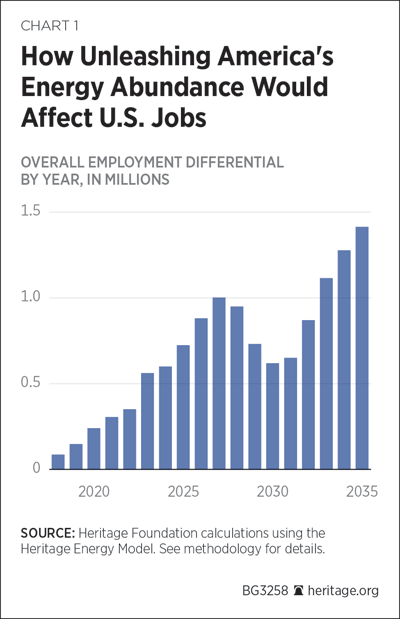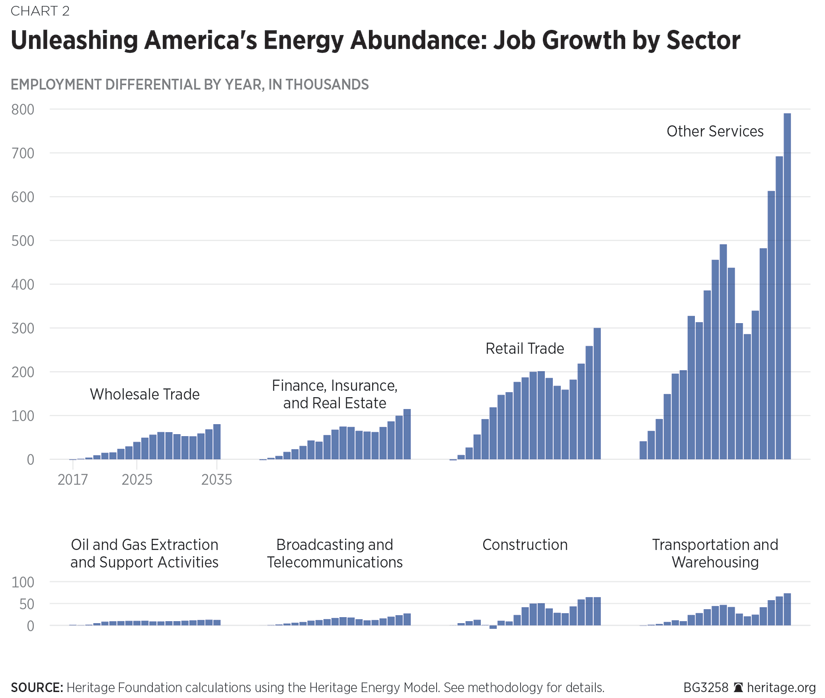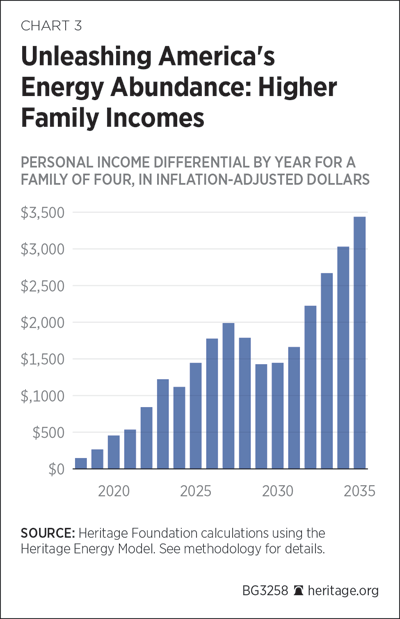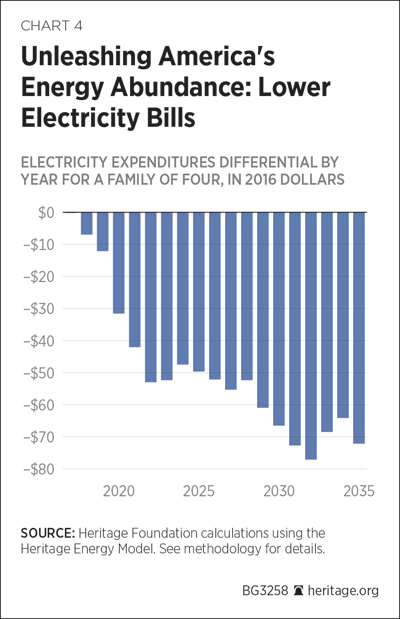Despite the success that the U.S. has had as a global energy powerhouse,[REF] a number of government-imposed obstacles prevent Americans benefiting from the nation’s rich wealth of natural resources. Earlier in 2017, President Trump issued the Energy Independence Executive Order, which directs federal agencies to review, rescind, and potentially replace burdensome regulations that obstruct energy development.[REF]
Opening access to the nation’s vast energy resources will unleash American ingenuity and talent, lower energy bills for families and businesses, and create hundreds of thousands of jobs for years to come. President Trump and Congress should implement the necessary policy reforms to enable the energy industry to capitalize even further on America’s energy abundance.
Energy’s Importance to Quality of Life and the Economy
Energy is ubiquitous in today’s economy. From heating and cooling homes, to powering businesses, schools and hospitals, to moving goods and people across the world, energy is a critical component to quality of life in the U.S. Harnessing the U.S.’s abundant natural resources not only provides families with a reliable source of energy, but also significantly improves public health and well-being by serving as an input for medicines,plastics, fertilizers, cleaners, and much more.[REF]
Coal, oil, and natural gas meet more than 80 percent of America’s energy needs. In fact, these natural resources have comprised at least 80 percent of the nation’s energy mix for more than a century.[REF] Conventional fuels, often derided by environmental activists as an energy source of the past, could actually meet the U.S.’s and the world’s energy demands for centuries to come. Conventional fuels will be essential to meeting future energy needs in the developing world, where more than 1.2 billion people (17 percent of the global population) do not have access to reliable electricity.[REF]
America’s Energy Abundance
The U.S., in addition to the rest of North America, is extremely energy rich. The Institute for Energy Research estimates that North American oil resources total nearly 1.8 trillion barrels of recoverable oil, over 75 percent of which is contained in the U.S.[REF] This oil is more than enough to meet the U.S.’s current energy demands for the next two centuries.[REF]
However, these estimates may in fact underestimate America’s energy wealth, because they fail to keep up with technological advancements discovering new resources. In fact, innovative companies have squashed exaggerated claims of looming resource exhaustion. Allen Gilmer, Co-Founder and Executive Chairman of Drillinginfo, recently called the Permian Basin in west Texas and southeastern New Mexico “a permanent resource.”[REF] Gilmer remarked:
The research we’ve done indicates that we have at least half a trillion barrels in the Permian at reasonable economics, and it could be as high as 2 trillion barrels. That is, as a practical matter, an infinite amount of resource.[REF]
Accessing the Abundant Energy: Horizontal Drilling and Hydraulic Fracturing
Oil and natural gas extraction in the U.S. is a fundamentally different process than that found in places like Canada, the Middle East, Venezuela, or offshore operations. In the U.S., companies extract these resources, known as tight oil or shale oil/gas, through a combination of horizontal drilling and hydraulic fracturing.
- Horizontal drilling is an innovative method that assists shale oil and gas extraction. In this approach, energy companies drill down and subsequently outward (horizontally). Horizontal drilling enables producers to significantly expand their search horizons and extract more oil and gas in a quicker and more efficient manner than typical vertical drilling allows. Horizontal drilling also drastically reduces the surface area footprint of the drilling activities, minimizing the visible environmental footprint.
- Hydraulic fracturing, often referred to as fracking, enables producers to extract oil and natural gas trapped in rock deposits. Producers drill wells that on average are 7,500 feet below the surface—thousands of feet underneath drinking water aquifers—and inject water, sand, and chemical additives deep in the ground at high pressure to fracture the forms or formations. The fracturing releases trapped oil and gas, which is then pumped to the surface.
Hydraulic fracturing and horizontal drilling are imperative to the safe and efficient extraction of recoverable oil and gas in various parts of the country, generating tremendous economic growth and job creation.[REF] However, misinformation from environmental activist organizations has demonized fracking and the fossil fuel industry. Opponents have deemed the process unsafe, arguing that fracking contaminates drinking water.[REF] A number of academic studies have discredited this claim, finding no widespread, systemic contamination because of the fracking process.[REF] Both the Environmental Protection Agency (in a five-year study) and the U.S. Geological Survey recently found that fracking has not adversely affected drinking water.[REF] Environmental organizations also claim that continued reliance on conventional fuels exacerbates catastrophic global warming, despite the fact that natural gas decreases carbon-dioxide (CO2) emissions.[REF] This Backgrounder includes simulations of impacts on the climate from increase in oil and natural gas production to assess the legitimacy of claims.
Energy companies have capitalized on the wealth of resources underneath U.S. soil on state and privately owned lands. The energy industry and consumers alike benefit from most of the shale oil and shale gas in the U.S. not being under federal control. However, federal regulations and federal land ownership have rendered vast quantities of recoverable oil and natural gas onshore and offshore either inaccessible or costlier to extract.[REF] A burdensome environmental review and permitting process for resource extraction on federal lands, including the climate change regulation of methane emissions, restrict the accessibility of energy resources on federal lands for little to no environmental benefit.
Climate Impact of Increased Oil and Gas Production
To assess the veracity of claims that increased oil and gas production, especially fracking, would lead to exacerbated global warming, we used the Model for the Assessment of Greenhouse Gas Induced Climate Change (MAGICC)—also used by the Intergovernmental Panel on Climate Change—to estimate how temperatures and sea levels would change as a result of increased CO2 emissions resulting from our policy scenario.[REF]
Even under the dubious assumption that a doubling of CO2 emissions significantly increases warming, our simulations indicate that, by 2100, global temperature would change by no more than 0.003 degrees Celsius and sea levels would rise by no more than 0.02 cm. The MAGICC model simulations, in conjunction with the results from HEM, thus demonstrate that accessing the U.S.’s vast oil and gas supply would have tremendous economic benefits and negligible impact on the climate.
The Economic Impact of Using U.S. Oil and Gas Resources
To quantify the economic impact of capitalizing on our vast oil and gas supply, we used the Heritage Energy Model (HEM). We performed a simulation comparing current policy to a policy assuming that the recoverable shale oil and shale gas are 50 percent higher through greater access, reduced regulations, and improved efficiencies. All of the assumptions are set forth in the Appendix.[REF]
The combination of a rational regulatory environment with open access could put a 50 percent increase within reach. Although lower energy prices may tamper new investments, companies are reducing operating costs and improving efficiency to enhance productivity.[REF] Vice Chairman of IHS Markit Daniel Yergin remarked, “The industry is in the middle of re-engineering its processes and its technologies to be a $50 industry, not a $100 industry.”[REF]
Chart 1 provides the impact, based on the simulation results, of lifting unnecessary regulations and taking advantage of the abundant oil and gas resources our country has to offer.

The prospect of fracking creates employment opportunities for those directly associated with the extraction including data scientists, engineers, and geologists. Moreover, the energy boom provides more employment opportunities for local businesses near extraction sites such as hardware stores, hotels, laundromats, restaurants, and so forth. Chart 1 illustrates a peak employment gain of 1.4 million new jobs and average gains of over 660,000 jobs. These gains occur for a variety of reasons.
Even for businesses not directly or indirectly associated with energy production, cheaper energy lowers the cost of doing business. Nearly every business in the U.S. uses energy as an input cost for its product, whether it is as simple as paying the electricity bill or filling up a vehicle with gasoline or diesel to transport goods. Cheaper energy means companies across the country would incur lower operational costs and therefore have more resources to invest in labor and capital.
Chemical companies are investing heavily in the U.S., citing the affordable and abundant natural gas as their motivation. As of July 2017, the American Chemistry Council reports that the industry is cumulatively investing $185 billion on 310 projects in the U.S.[REF] Chart 2 shows some of the industries that would reap tremendous benefits from increased energy production.

The economic gains at the industry level are impressive, but individuals and households also receive remarkable financial benefits. The dramatic increase in oil and natural gas production drives down prices, putting money back in the wallets of Americans. Cheaper energy lowers the cost of living. After accounting for inflation, overall energy expenditures in 2015 were the lowest since 2004, driven in large part because of increased supplies.[REF] According to the U.S. Energy Information Administration, “In constant 2015 dollars, average annual household energy expenditures peaked at about $5,300 in 2008. Between 2008 and 2014, average annual household energy expenditures declined by 14.1%.”[REF]
Increased energy supplies will drive prices down further, generating significant cost savings and overall economic gains to households. As Chart 3 illustrates, the average family of four gains over $27,000 by 2035. In terms of total gross domestic product, these gains translate to an increase of over $2.4 trillion.

Our analysis also computed the changes in annual electricity expenditures for a family of four. Annual electricity expenditures will decline, resulting in a total savings of nearly $1,000 for such a household. These savings are particularly important for low-income families and seniors on fixed incomes where energy costs represent a larger portion of their budget.[REF] When low-income households are making difficult decisions regarding health care and access to food, the additional energy savings are essential to a better quality of life.

How to Capitalize on America’s Energy Abundance
President Trump’s energy independence executive order includes direction to open access to resources on federal lands and review, suspend, revise, or rescind a number of regulations.[REF] The simulation results above illustrate the vast gains that would occur if policymakers open access to off-limits areas, streamline the permitting process, and reduce the regulations with no direct, substantial environmental benefits. Working with Congress, the Trump Administration can leave a legacy that fundamentally changes how energy investments are made. To achieve these gains, federal and state policymakers should:
Open Access to Energy Exploration of Federal Waters and Lands.The Administration should open all federal waters and federal lands that are not part of the national park system or congressionally designated areas to exploration and production for all of America’s natural resources. Congress should require the Department of the Interior (DOI) to conduct lease sales, rather than develop five-year planning programs, if a commercial interest exists. The lease plans do not reflect dynamic market conditions that affect companies’ decisions to explore and develop offshore resources. Congress and the Administration should overhaul the leasing process that ensures access to safely develop energy off America’s coasts.
Reverse Federal Regulations on Fracking. Federal regulations duplicate existing state regulation on fracking since companies must obtain state permits for all wells, including federal wells, and must comply with all state regulations. Citizens working with state and local bureaucrats have a significantly better sense about increasing economic growth while protecting their environment. The federal government should rescind all methane regulations for oil and gas activities, which will drive costs higher for no climate benefit.[REF]
Allow States to Manage Energy Development. Permitting energy extraction on federally owned land will result in even more oil and gas extraction and create jobs in areas that would otherwise not see such economic growth. The average period for the federal government to process an application for permit to drill (APD) lasts for months (sometimes over a year), whereas states process an APD in days or weeks. The DOI should reduce the APD time frames to that of states.
A better solution requires legislative change, wherein Congress grants authority to state regulators to oversee the environmental review and permitting of energy projects on federal lands within their borders. The Federal Land Freedom Act, which would allow states to regulate energy development, will produce better economic and environmental results.[REF] Ultimately, Congress should explore ways to sell federal lands to states and private individuals who are in a better position to reap the benefits from energy production while protecting the environment.
Streamline the National Environmental Policy Act (NEPA) Process. The NEPA requires federal agencies to conduct comprehensive environmental impact assessments for a wide range of projects, including energy extraction on federal lands. A number of factors result in NEPA delays at the federal, state, and local level. At the federal level, some of the major issues include differing interpretations of NEPA requirements, failed interagency coordination, administrative bottlenecks, and outdated requirements that fail to take into account changing conditions. In fact, the Obama Administration recognized that the federal government could expedite permitting without sacrificing environmental protection by effectively relinquishing NEPA requirements for a large number of projects funded by the American Recovery and Reinvestment Act.
Empowering states to regulate energy production on federal lands would satisfy all NEPA requirements. Without legislative reform, however, the Trump Administration should require agencies to complete environmental assessments as expeditiously as possible. Reforms include:
- Properly shaping the scope of the project.Agencies control the substance of a NEPA analysis by shaping the “scope” (i.e., the purpose and need) of the project. As a result, the agencies can effectively control the outcome of the NEPA review through deliberate scoping. Therefore, the utmost constraint should be exercised in scoping to ensure that the NEPA analysis is targeted and relevant, thus helping to reduce legal challenges and shorten the review.
- Eliminating redundancies.The multitude of other regulatory requirements makes a full-scale NEPA review redundant. The Council on Environmental Quality (CEQ) should allow agencies to treat existing analyses as functional equivalents for project elements that have been previously reviewed.
- Ensuring scientific transparency and integrity.The scientific integrity of the NEPA process suffers from a lack of consistent methodology. The CEQ has left agency officials free to apply any assessment approach of their choosing, but thorough cost-benefit analyses are rare. The CEQ should carefully monitor the scientific validity of information/data used in the review, and reject unsound findings.
- Establishing a lead agency and restricting the input of other agencies.Responsibility for the NEPA review should be assigned to a “lead” department. The involvement of other agencies should be strictly limited to issues that fall within their specified jurisdiction or expertise.
Allow Fracking on Private Land. Property rights are a fundamental component of American society. Individuals should have the right to use their property as they see fit and have the freedom to contract with private employees to frack on their own lands if they so desire. Proper enforcement of property rights, in conjunction with appropriate regulations implemented by state and local governments, enable the extraction of potentially valuable resources and the protection of the environment.[REF] States should not issue blanket moratoriums on fracking that strip away these rights.
Prohibit Taxes or Regulations Regarding Greenhouse-Gas Emissions. Past Heritage Foundation research has demonstrated that any carbon tax or climate change regulations will reduce energy supply, raise energy costs, and eliminate jobs, but have an insignificant impact on global temperatures.[REF] The Environmental Protection Agency and the DOI should rescind these regulations and Congress should clarify that the Clean Air Act was never intended to regulate CO2 and other greenhouse-gas emissions and prohibit any further climate regulations.
Conclusion
The U.S. has a vast supply of oil and gas running beneath it. Capitalizing on this vast supply will have tremendous economic benefits, creating hundreds of thousands of jobs and making families all across the country more prosperous in the process. Policymakers should pursue policies to unlock these resources.
—Kevin D. Dayaratna, PhD, is Senior Statistician and Research Programmer in the Center for Data Analysis, of the Institute for Economic Freedom, at The Heritage Foundation. Nicolas D. Loris is Research Manager and Herbert and Joyce Morgan Research Fellow in Energy and Environment in the Thomas A. Roe Institute for Economic Policy, of the Institute for Economic Freedom.
Appendix: Methodology
The Heritage Energy Model
The analysis in this Backgrounder uses the Heritage Energy Model (HEM), a derivative of the National Energy Model System 2017 Full Release (NEMS).[REF] The NEMS is used by the Energy Information Administration (EIA) in the Department of Energy as well as various nongovernmental organizations for a variety of purposes, including forecasting the effects of energy policy changes on a plethora of leading economic indicators.
The methodologies, assumptions, conclusions, and opinions in this Backgrounder are entirely the work of statisticians and economists in the Center for Data Analysis (CDA) at The Heritage Foundation, and have not been endorsed by, and do not necessarily reflect the views of, the developers of the NEMS.
The HEM is based on well-established economic theory as well as historical data, and contains a variety of modules that interact with each other for long-term forecasting. In particular, the HEM focuses on the interactions among
- The supply, conversion, and demand of energy in its various forms;
- American energy and the overall American economy;
- The American energy market and the world petroleum market; and
- Current production and consumption decisions as well as expectations about the future.[REF]
These modules are the:
- Macroeconomic Activity Module,[REF]
- Transportation Demand Module,
- Residential Demand Module,
- Industrial Demand Module,
- Commercial Demand Module,
- Coal Market Module,
- Electricity Market Module,
- Liquid Fuels Market Module,
- Oil and Gas Supply Module,
- Renewable Fuels Module,
- International Energy Activity Module, and
- Natural Gas Transmission and Distribution Module.
The HEM is identical to the EIA’s NEMS with the exception of the Commercial Demand Module. The Commercial Demand Module makes projections regarding commercial floor-space data of pertinent commercial buildings. Other than the HEM not having this module, it is identical to the NEMS.
Overarching the 12 modules is the Integrating Module, which consistently cycles, iteratively executing and allowing these various modules to interact with each other. Unknown variables that are related, such as a component of a particular module, are grouped together, and a pertinent subsystem of equations and inequalities corresponding to each group is solved via a variety of commonly used numerical analytic techniques, using approximate values for the other unknowns. Once a group’s values are computed, the next group is solved similarly, and the process iterates. Convergence checks are performed for each price and quantity statistic to determine whether subsequent changes in that particular statistic fall within a given tolerance. After all group values for the current cycle are determined, the next cycle begins. For example, at a particular cycle, a variety of pertinent statistics, is obtained.[REF] The HEM provides a number of diagnostic measures, based on differences between cycles, to indicate whether a stable solution has been achieved.
This report uses the HEM to analyze the impact of making hydraulic fracturing more feasible by increasing the availability of petroleum in North America. In particular, we ran two of the same simulations which the EIA used in “Annual Energy Outlook 2017,” in comparing the greater availability of shale oil, shale gas, and its variants in North America with current policy.[REF]


